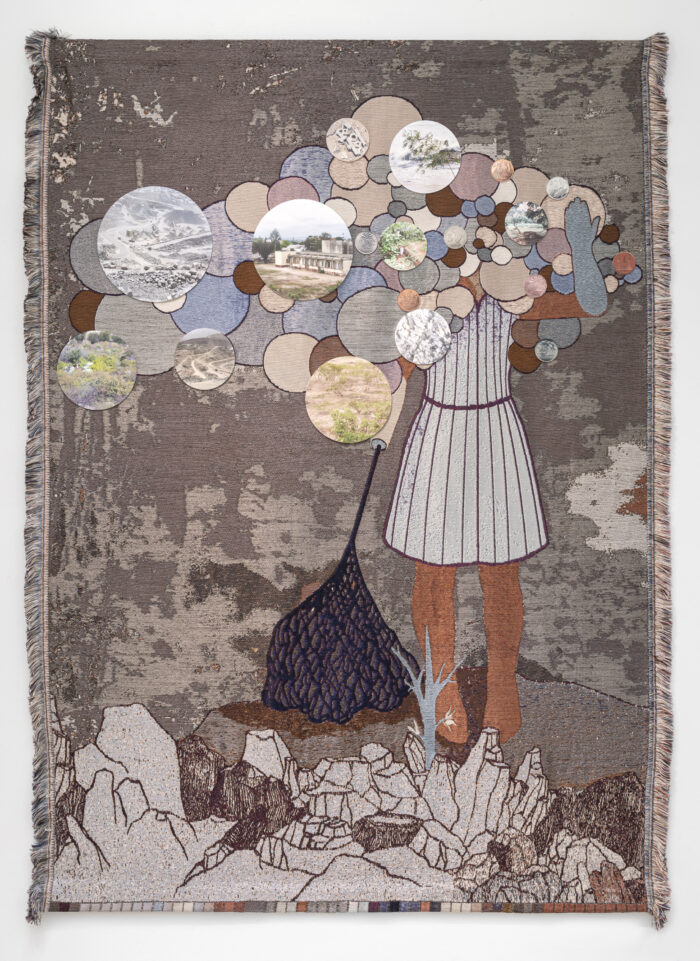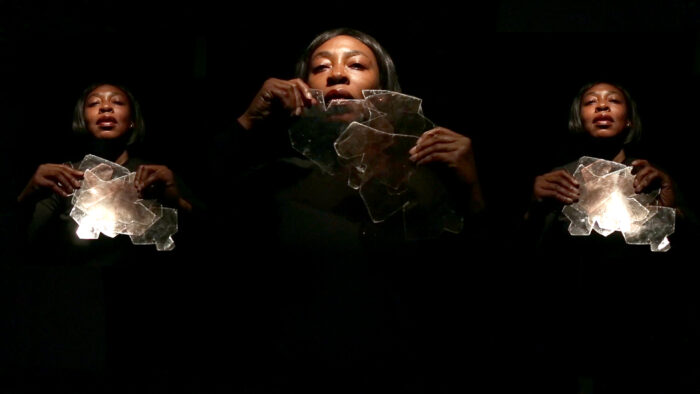Otobong Nkanga: Gently Basking in Debris
February 3–April 23, 2023

NASHVILLE, Tenn. (January 4, 2023)—The Frist Art Museum presents Otobong Nkanga: Gently Basking in Debris, a selection of paintings, tapestries, drawings, video, sculpture, and more that make metaphorical connections between the landscape and human body. Organized by the Frist Art Museum, Gently Basking in Debris will be on view in the Frist’s Gordon Contemporary Artists Project Gallery from February 3 through April 23, 2023, and is part of the Tennessee Triennial for Contemporary Art, a program of Tri-Star Arts.
Born and raised in Nigeria, Otobong Nkanga has lived and studied in several cities across Europe and now resides in Antwerp, Belgium. Ideas in her work relate to crossing between geographical places and cultural identities and reflect her itinerant life. “Nkanga sees history, memory, economics, and geography flowing like a river through the human body,” writes Frist Art Museum chief curator Mark Scala. “Straddling nature and society, the body can be a metaphor for global fracture or connectedness. It mirrors the earth: Both contain the same elements and minerals. Both bear the scars of exploitation. Both need patience and love to be made whole.”
Environmental degradation and healing are major themes in Nkanga’s work. Fragmented figures—wounded and headless bodies—signify damaged environments and serve as actors in an epic story across her body of work. The project’s title, Gently Basking in Debris, implies human passivity to a mounting pile of wreckage in nature and society. Yet Nkanga suggests that art can stimulate awareness and restorative action.

As part of the statewide Tennessee Triennial for Contemporary Art, Gently Basking in Debris responds to the theme of “Re-Pair” envisioned by consulting curator María Magdalena Campos-Pons of Vanderbilt University’s Engine for Art, Democracy & Justice. Nkanga’s works align with Campos-Pons’s call for art “to re-pair, patch and rebuild our fragile spirits, bodies, cities, political institutions and economic relationships.” For Nkanga, such repair is emotional and spiritual. “To care,” she says, “is a form of resistance. We have to enter into the space of resistance—of singing together and caring for each other’s souls.”
Nkanga is well known for creating large tapestries, working in a medium suited to conveying interconnectedness. That theme is beautifully illustrated in Revelations (fig. 2), in which a woman is surrounded by a cloud of picture-bubbles. “The bubbles contain images of sites of industrial extraction, exchange, and loss, constituting cultural and personal memories that threaten to overwhelm the woman,” writes Scala. “Her right hand is depicted as a net holding empty circles—bubbles of the future, open to the construction of new memories, which might break the cycle in which she seems trapped.”
At nearly twenty feet across, the wall-sized tapestry Tied to the Other Side (fig. 1) depicts a mysterious environment in which the earth or possibly a seabed is littered with people’s arms. “The arms represent the instruments of labor and agency that have been discarded after outliving their usefulness,” writes Scala. “At center, a dead figure morphs into a jewel-like growth, a luminous coral or exotic plant—the body returns to nature. Beams of light are directed toward the left, cut off by the edge of the tapestry, evoking a searchlight or a way-finder aimed toward a future of new possibilities.”
Addressing the detrimental impact of the extraction of minerals used in fashion and cosmetics, the video In Pursuit of Bling (fig. 3) connects the mineral mica with skin, flesh, and the earth. Mined heavily in many parts of the world, mica is exported for use in industry and beauty products. “As a child in Lagos, Nkanga smeared glittering mica dust on her own skin,” writes Scala. “At the time, she did not know about the mechanisms of production and consumption fueling the cosmetics industry, but she knew about disco bling and Diana Ross sparkle. Only later did she weigh the desire for glitter against the damage done to the earth to fulfill that desire.”

The towers of soap from Nkanga’s Carved to Flow project were first shown in a 2017 installation and performance at documenta 14, an international exposition held in Athens, Greece, and Kassel, Germany. For this project, Nkanga held a soapmaking workshop in Athens, where prototypes were created using water, coal, lye, and seven butters and oils from the Mediterranean, the Middle East, and North and West Africa. The black soap symbolically connects historical narrative, landscapes, and as Scala writes, “is a means of situating bodily intimacy and cultural memory within a global framework of manufacturing and distribution.” Individual soap bars have been sold in Kassel and elsewhere, with the proceeds funding an art space in Athens as well as the Carved to Flow Foundation, a non-profit in Uyo, Akwa Ibom State, in Nigeria. Each one that is sold is wrapped in paper printed with a poem by the artist. Altogether, the project is an example of Nkanga’s vision for a path from historical oppression and conflict toward an economics of empathy.
About the Artist
Otobong Nkanga was born in Kano, Nigeria, in 1974. She studied art at Obafemi Awolowo University in Ile-Ife and École des Beaux-Arts in Paris, France. She then earned a master’s degree in performing arts from the DAS Graduate School at Amsterdam University of the Arts. She lives and works in Antwerp, Belgium.
Nkanga’s works have been presented in many solo exhibitions, including Underneath the Shade We Lay Grounded, Sint-Janshospitaal, Bruges, Belgium (2022); Otobong Nkanga, Kunsthaus Bregenz, Bregenz, Austria (2021–22); Of Cords Curling around Mountains, Castello di Rivoli Museo d’Arte Contemporanea, Rivoli, Italy (2021–22); When Looking Across the Sea, do you Dream?, Villa Arson, Nice, France (2021); Uncertain Where the Next Wind Blows, Henie Onstad Kunstsenter, Høvikodden, Norway (2020–21); To Dig a Hole that Collapses Again, Museum of Contemporary Art Chicago, Chicago, Illinois (2018); and Diaoptasia, Tate Modern, London, England (2015). Additionally, her work has been featured in the Busan Biennale, Busan, Korea (2022); La Biennale di Venezia, Venice, Italy (2019); Sharjah Biennial, Sharjah, United Arab Emirates (2019); Musée d’Art Moderne et d’Art Contemporain, Nice, France (2018);Moscow Museum of Modern Art, Moscow, Russia(2018); documenta 14, Athens, Greece, and Kassel, Germany (2017); Stedelijk Museum Amsterdam, Amsterdam, Netherlands (2017); the European Biennial of Contemporary Art, Amsterdam, Netherlands (2017); Moderna Museet, Stockholm, Sweden (2016); Centre Pompidou, Paris, France (2016); and the 13th Biennale de Lyon, Lyon, France (2015).
Organizational Credit
Organized by the Frist Art Museum. This project is part of the Tennessee Triennial for Contemporary Art, a program of Tri-Star Arts.
Supporter Acknowledgment
Lead Sponsor: Blevins, Inc.
Funded in part by the Gordon CAP Gallery Fund
With additional support from Friends of Contemporary Art
The Frist Art Museum is supported in part by The Frist Foundation, Metro Arts, the Tennessee Arts Commission, and the National Endowment for the Arts.
Connect with us @FristArtMuseum #TheFrist #FristOtobongNkanga
FOR ADDITIONAL INFORMATION
Buddy Kite: 615.744.3351, bkite@FristArtMuseum.org
Ellen Jones Pryor: 615.243.1311, epryor@FristArtMuseum.org
